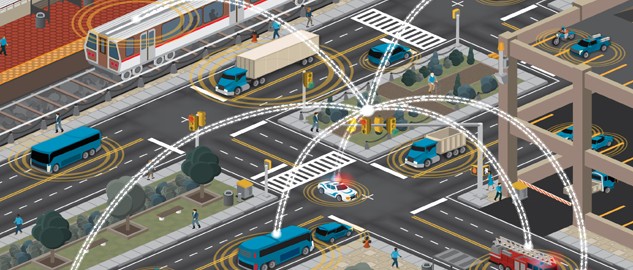V2I Spectrum-Sharing Field Test is Ongoing
Burney Simpson
Field tests of a program that allows Wi-Fi and Vehicle-to-Infrastructure (V2I) communications to share a sector of the radio frequency spectrum are scheduled to be completed by the end of the year.
The testing of the 5.9 Gigahertz (GHz) band follows the May 13 announcement by Department of Transportation Secretary Anthony Foxx that the DOT would expedite research into sharing the band with unlicensed users, such as consumers and businesses.
In 1999 the Federal Communications Commission set-aside the 5850 to 5925 segment of the spectrum for Dedicated Short-Range Communications (DSRC) to improve roadway safety. The Department of Transportation has been devoting this space, known as the 5.9 band, to V2I communications. The FCC regulates the use of the spectrum.
The week before Foxx’s announcement, officials from Cisco Systems, GM and others met with FCC commissioners to discuss testing a program Cisco called “Listen, Detect, and Avoid” protocol that could allow for use of Wi-Fi in the 5.9 band without interfering with DSRC.
Cisco has allied with the Alliance of Automobile Manufacturers and the Global Automakers, two trade groups representing auto OEMs, in its development and promotion of Listen, Detect, and Avoid. A second DSRC-sharing proposal from Cisco competitor Qualcomm was turned down by the FCC.
A letter from Global Automakers to the FCC pledged to complete field testing of the Cisco concept by the end of this year.
Spectrum sharing proponents argue that Wi-Fi needs more bandwidth due to the exponential growth in the use of tablets and smart phones since the 1999 FCC set-aside.
However, some in the transportation industry active in DSRC and autonomous vehicles have been wary of the idea.
Shortly before Foxx requested the speed up of work on V2V and V2I technology, an independent committee of transportation experts recommended the DOT move slowly with sharing the DSRC spectrum with Wi-Fi uses.
The Transportation Research Board in April sent a report to Foxx that warned “proposed spectrum sharing in the 5.9 GHz band is the most serious risk and uncertainty for the program, but it is not the only one.”
The report, prepared at the request of the DOT, noted that there were many “unknowns and uncertainties” regarding implementation of DSRC by the government and industry.
In addition, Peter Sweatman, director of the University of Michigan Transportation Research Institute, testified to a Congressional committee this year that he had reservations about spectrum sharing (“GM to Congress: We’ll Test Wi-Fi in DSRC Spectrum”).
“Our entire ecosystem of companies (are) committed to V2V using the 5.9 GHz spectrum,” Sweatman told the U.S. House Subcommittee on Commerce, Manufacturing, and Trade. “Spectrum must be protected for (V2V) safety performance (which) depends on the absolute reliability of messages, as well as certainty in spectrum availability, in the mode that has been fully tested.”


